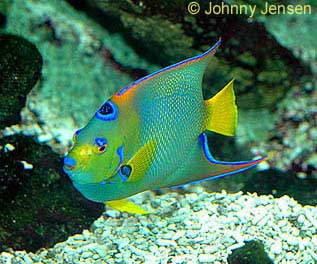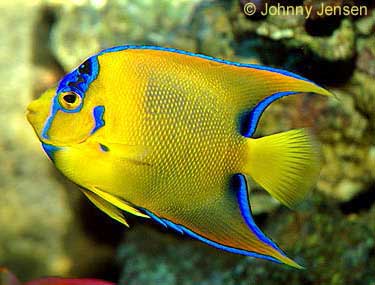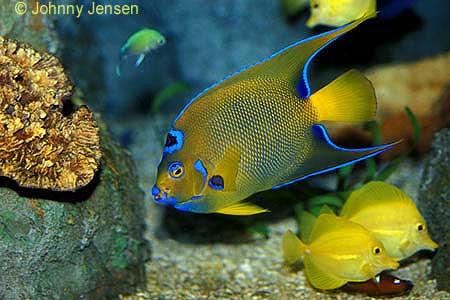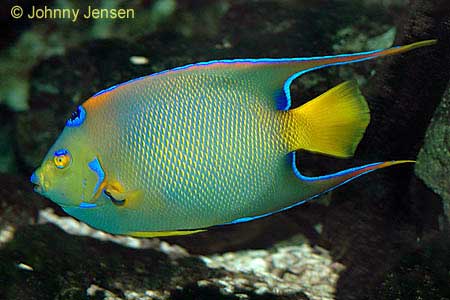|
|
Queen Angelfish

The Queen Angelfish is also known as the Yellow Angel, the Golden Angel and the Blue Angel. The
Blue Angel is a poor name choice, as this commonly refers to Holocanthus bermudensis instead.
The Queen Angel comes from the western Atlantic, ranging all the way from Florida to Brazil.
Juveniles are often confused with the Blue Angel. The Queen Angel has a distinctive crown on
its head, which gives rise to its name. The crown is a black spot on with electric blue highlights
and an outer electric blue ring. There is also iridescence throughout the basic body coloring.
The dorsal and anal fins extend laterally to long points. Juveniles have a very dark coloration
with vertical arched stripes. The juvenile coloration is nearly identical to the Blue Angel,
however the stripes on the Blue are straight vertical ones. As adults, the Queen is easily
distinguished by its colored crown and completely yellow tail.

The Queen Angel is not a good beginner's fish because of its large size, its aggressiveness
and its cost. It is still a quite popular choice though because of its striking colors. When
buying a Queen Angel, select one of 3 - 6 inches, as these have the best survival rates. Try
to make this fish the last addition to a tank in order to reduce its aggression. The tank should be 150 gallons. There should be lots of hiding places and live rock.
In the wild the Queen
Angel eats algae, sponges and zooplankton. It will nip at hard corals, soft corals and clams,
but its primary dietary source is sponges. Its aquarium diet should include dried seaweed
(nori), fresh and frozen shrimp and spirulina flakes. A high quality sponge based flake food,
such as Angel Formula by Ocean Nutrition, should be used. The diet can be supplemented with
small amounts of chopped fresh and frozen crustaceans, shellfish and squid. The Queen Angel
should be fed several times per day, but care should be taken to ensure all food is eaten
immediately so that water quality is not impaired.
Queen Angels are normally found in pairs in the wild. Females can produce more than 10,000
eggs during spawning. The eggs float with the tide and hatch within a day or two. Juveniles will
act as cleaners for other fish, while adults subsist mainly on sponges. Queen Angels can
breed with Blue Angels to produce a hybrid called a Townsend Angel.
Queen Angels are not successfully bred in captivity.


| Scientific Name: |
Holacanthus ciliaris |
| Family: |
Pomacanthidae |
| Care: |
Difficult |
| Temperature: |
22 - 26 C; 72 - 79 F |
| pH: |
8.1 - 8.4 |
| dH: |
8 - 12 |
| Specific Gravity: |
1.020 - 1.025 |
| Size: |
45 cm; 18 inches |
| Breeding: |
Egg Layer |
| Life Span: |
15 years |
| Crustacean Safe: |
No |
| Coral Safe: |
No |
|
Compatibility:
|
|
Does well in a Fish Only tank. They should not be kept with other Angels and only one should be kept per tank. Suitable tank mates include Butterflies, Tangs and Wrasses.
|
|